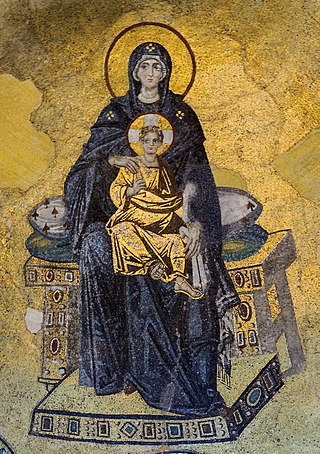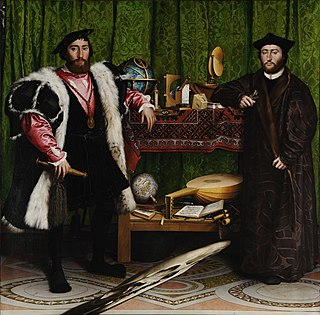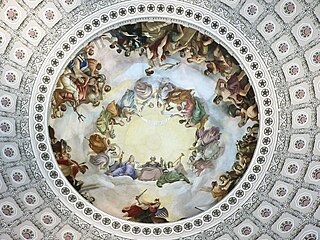Related Research Articles
The history of religion refers to the written record of human religious feelings, thoughts, and ideas. This period of religious history begins with the invention of writing about 5,200 years ago. The prehistory of religion involves the study of religious beliefs that existed prior to the advent of written records. One can also study comparative religious chronology through a timeline of religion, or the interrelationships and historical diversification of religious ideologies through the use of evolutionary philosophy and broad comparativism. Writing played a major role in standardizing religious texts regardless of time or location and making easier the memorization of prayers and divine rules.
Religion is a range of social-cultural systems, including designated behaviors and practices, morals, beliefs, worldviews, texts, sanctified places, prophecies, ethics, or organizations, that generally relate humanity to supernatural, transcendental, and spiritual elements—although there is no scholarly consensus over what precisely constitutes a religion. Different religions may or may not contain various elements ranging from the divine, sacredness, faith, and a supernatural being or beings.

Idolatry is the worship of an idol as though it were a deity. In Abrahamic religions idolatry connotes the worship of something or someone other than the Abrahamic God as if it were God. In these monotheistic religions, idolatry has been considered as the "worship of false gods" and is forbidden by texts such as the Ten Commandments. Other monotheistic religions may apply similar rules.

Religious art is a visual representation of religious ideologies and their relationship with humans. Sacred art directly relates to religious art in the sense that its purpose is for worship and religious practices. According to one set of definitions, artworks that are inspired by religion but are not considered traditionally sacred remain under the umbrella term of religious art, but not sacred art.

In sociology, secularization is a multilayered concept that generally denotes "a transition from a religious to a more worldly level." There are many types of secularization and most do not lead to atheism, irreligion, nor are they automatically antithetical to religion. Secularization has different connotations such as implying differentiation of secular from religious domains, the marginalization of religion in those domains, or it may also entail the transformation of religion as a result of its recharacterization.

Iconography, as a branch of art history, studies the identification, description and interpretation of the content of images: the subjects depicted, the particular compositions and details used to do so, and other elements that are distinct from artistic style. The word iconography comes from the Greek εἰκών ("image") and γράφειν.

In Indian religions, a darshan or darshanam is the auspicious sight of a deity or a holy person.
Visual culture is the aspect of culture expressed in visual images. Many academic fields study this subject, including cultural studies, art history, critical theory, philosophy, media studies, Deaf Studies, and anthropology.

John Corrigan is an American religion scholar and historian, known for being the author of a number of books on the history of religion and emotion, and the digital humanities. He is the Lucius Moody Bristol Distinguished Professor of Religion and Professor of History, and Distinguished Research Professor at Florida State University (FSU). He is a leader in the academic study of religion and emotion and in the field of the spatial humanities. His narrative histories of religion in America are widely adopted in university courses.

American civil religion is a sociological theory that a monotheistic nonsectarian civil religion exists within the United States with sacred symbols drawn from national history. Scholars have portrayed it as a common set of values that foster social and cultural integration. The ritualistic elements of ceremonial deism found in American ceremonies and presidential invocations of God can be seen as expressions of the American civil religion.

The Head of Christ, also called the Sallman Head, is a 1940 portrait painting of Jesus of Nazareth by Warner Sallman (1892–1968). As an extraordinarily successful work of Christian popular devotional art, it had been reproduced over half a billion times worldwide by the end of the 20th century. Enlarged copies of the work have been made for churches, and small pocket or wallet-sized prayer cards bearing the image have been mass-produced for private devotional use. The painting is said to have "become the basis for [the] visualization of Jesus" for "hundreds of millions" of people.
Postsecularism refers to a range of theories regarding the persistence or resurgence of religious beliefs or practices in the present. The "post-" may refer to after the end of secularism or after the beginning of secularism.
The archaeology of religion and ritual is a growing field of study within archaeology that applies ideas from religious studies, theory and methods, anthropological theory, and archaeological and historical methods and theories to the study of religion and ritual in past human societies from a material perspective.

Christian culture generally includes all the cultural practices which have developed around the religion of Christianity. There are variations in the application of Christian beliefs in different cultures and traditions.
Ellen Spolsky is Professor Emerita of English at Bar-Ilan University, Israel. She is a literary scholar and theorist who has published several monographs that deal with topics such as early English literary history, Shakespeare, history of literary theory, word and image relations, cognitive cultural theory, iconotropism, performance theory, and some aspects of evolutionary literary theory. Her books and essays discuss both the universal and historically local aspects of Renaissance art, poetry and drama.

Affective piety is most commonly described as a style of highly emotional devotion to the humanity of Jesus, particularly in his infancy and his death, and to the joys and sorrows of the Virgin Mary. It was a major influence on many varieties of devotional literature in late-medieval Europe, both in Latin and in the vernaculars. This practice of prayer, reading, and meditation was often cultivated through visualization and concentration on vivid images of scenes from the Bible, Saints' Lives, Virgin Mary, Christ and religious symbols, feeling from the result. These images could be either conjured up in people's minds when they read or heard poetry and other pieces of religious literature, or they could gaze on manuscript illuminations and other pieces of art as they prayed and meditated on the scenes depicted. In either case, this style of affective meditation asked the "viewer" to engage with the scene as if she or he were physically present and to stir up feelings of love, fear, grief, and/or repentance for sin.

David Alfred Martin, FBA was a British sociologist and Anglican priest who studied and wrote extensively about the sociology of religion.
Feminist art criticism emerged in the 1970s from the wider feminist movement as the critical examination of both visual representations of women in art and art produced by women. It continues to be a major field of art criticism.

The Carolingian Cross is but one variation in the vast historical imagery of Christian symbolic representations of the Crucifixion of Jesus, going back to at least the ninth century. All crosses and Christian symbols have an inherent meaning arising from a multitude of sources and distinct features that set them apart from other religions. From both a design aspect and a theological perspective, the Carolingian Cross consists of a mixture of Christian and pre-Christian concepts built over a long history of cultural adaptation, religious iconography, liturgical practices and theological premises. German graphic designer Rudolf Koch in 1932 published a collection of 158 plates of drawings of Christian symbols. Under the heading of "Cross", this includes twelve drawings of Christian cross variants. One of these, the "Carolingian Cross" shows a cross of four triquetras.
Margaret Ruth Miles is an American theologian and historian who was president of the American Academy of Religion in 1999 and dean of the Graduate Theological Union from 1996 to 2001. A 1982 Guggenheim Fellow, she has written and edited dozens of books, including Augustine on the Body (1979), Image as Insight (1985), Immaculate and Powerful (1985), Shaping New Vision: Gender and Values in American Culture (1987), Seeing and Believing: Religion and Values in the Movies (1997), Plotinus on Body and Beauty (1999), Carnal Knowing (2006), Desire and Delight (2006), and A Complex Delight (2008).
References
- ↑ "Faculty | Religious Studies". Archived from the original on 2014-02-28.
- ↑ "David Morgan, Professor of Religious Studies". Scholars at Duke. Retrieved March 9, 2019.
- ↑ "Routledge research in religion, media and culture". Routledge Research in Religion, Media and Culture. OCLC 707337216.
- 1 2 Morgan, David (1999). Protestants & pictures: religion, visual culture and the age of American mass production. New York: Oxford University Press. ISBN 978-1-4294-0477-8. OCLC 252600851.
- 1 2 Morgan, David (1996). Icons of American Protestantism: the art of Warner Sallman. New Haven [Conn.: Yale University Press. ISBN 978-0-300-06342-4. OCLC 32968586.
- ↑ Images at Work : The Material Culture of Enchantment. Oxford University Press. February 2018. ISBN 9780190272111 . Retrieved March 9, 2019.
- ↑ Morgan, David (October 2015). The Forge of Vision: A Visual History of Modern Christianity. University of California Press. ISBN 9780520286955 . Retrieved March 9, 2019.
- ↑ Morgan, David (2012). The embodied eye: religious visual culture and the social life of feeling. Berkeley: University of California Press. ISBN 978-0-520-27222-4. OCLC 823768735.
- ↑ OCLC 40794763 Choice Reviews, September 2012. doi : 10.5860/CHOICE.50-0235.
- ↑ IMAGE online, issue 237, March 13, 2012, last accessed 29 October 2014.
- ↑ OCLC 823815996 Arnold, J.W (2012). The Embodied Eye: Religious Visual Culture and the Social Life of Feeling. By David Morgan, Religious Studies Review Vol. 38, No. 4, p. 233.
- ↑ Bandak, Andreas (2014). The Embodied Eye: Religious Visual Culture and the Social Life of Feeling, American Anthropologist Vol. 116, No. 1, pp. 220-21. OCLC 5563603945
- ↑ Jasper, David (2014). The Embodied Eye, Art and Christianity] No. 79, Autumn 2014, p. 13. OCLC 265813062
- ↑ Scheer, Monique (2012)] David Morgan, The Embodied Eye: Religious Visual Culture and the Social Life of Feeling, Journal of Religion in Europe Vol. 5, No. 4, pp. 531-33. OCLC 5672483805
- ↑ Stimson, Blake (2014). David Morgan, The Embodied Eye: Religious Visual Culture and the Social Life of Feeling, Critical Research on Religion August 2014 No. 2, pp. 215-218 OCLC 835889852
- ↑ Wagner, Dana Wiggins Logan (2013). The Embodied Eye: Religious Visual Culture and the Social Life of Feeling, Vol. 25, No. 1, pp. 165-66. OCLC 5595749554
- ↑ Morgan, David (2008). Sacred heart of Jesus: the visual evolution of a devotion. Amsterdam: Amsterdam University Press. ISBN 978-90-485-0339-1. OCLC 632758634.
- ↑ OCLC 711798187
- ↑ SilverPlatter Information, Inc; Association of College and Research Libraries (1988). Choice reviews. Place of publication not identified: SilverPlatter International. OCLC 40794763.
- ↑ Mathews, Mary Beth Swetnam (2009). The Lure of Images, Journal of American History Vol. 95, No. 4.
- ↑ Ramji, Rubina (2010). The Lure of Images: A History of Religion and Visual Media in America, Church History, vol. 79, no. 4, pp. 962-963. OCLC 688336100
- ↑ Siegler, Elijah (2010). Book Review, Nova Religio Vol. 14, No. 1, pp. 120-21. OCLC 5543118890
- ↑ Tiitsman, Jenna (2009). The Lure of Images: A History of Religion and Visual Media in America, Journal of the Scientific Study of Religion Vol. 48, No. 2, June 2009, pp. 405-408. OCLC 49890280
- ↑ Morgan, David (2005). The sacred gaze: religious visual culture in theory and practice. Berkeley: University of California Press. ISBN 978-0-520-93830-4. OCLC 58728584.
- ↑ . November 2005. doi : 10.5860/CHOICE.43-1515 OCLC 40794763
- ↑ OCLC 81610593 Scripture Bulletin Vol. 36, No. 1, p. 34. (2006)
- ↑ OCLC 23658809 The Art Newspaper No. 167, March 2006, p. 44. (2006)
- ↑ Buggeln, Gretchen (2007, Book Reviews - The Sacred Gaze: Religious Visual Culture in Theory and Practice, Winterthur Portfolio Vol. 41, No. 2/3, pp. 193-94. OCLC 174962258
- ↑ Carroll, Michael P. (2006). Book Reviews - The Sacred Gaze: Religious Visual Culture in Theory and Practice, American Journal of Sociology Vol. 111, No. 5, pp. 1611-1613. OCLC 103049294
- ↑ Dunn, Allen (2006). Book Reviews and Notes- The Sacred Gaze, Church History Vol. 75, No. 3, p. 708. OCLC 103165859
- ↑ Mitchell, Jolyon (2008). Book Review: Spiritual Images. David Morgan, The Sacred Gaze: Religious Visual Culture in Theory and Practice, 21, no. 2, 2008, p. 101 OCLC 261469624
- ↑ Pattison, Stephen (2006). The Sacred Gaze: Religious Visual Culture in Theory and Practice, Material Religion Vol. 2, No. 1, pp. 121-22. OCLC 828111170
- ↑ Schrodt, Paul (2007). The Sacred Gaze: Religious Visual Culture in Theory and Practice, Missiology: An International Review Vol. 35, No. 2, pp. 461-62. OCLC 716089501
- ↑ Winfield, Pamela (2007). Book Reviews - The Sacred Gaze: Religious Visual Culture in Theory and Practice, Journal of Religion Vol. 87, no. 1, pp. 150-51. OCLC 102710257
- ↑ Christian Century Company; Disciples Publication Society; Christian Century Press; Christian Century Foundation (1902). "The Christian century". The Christian Century. ISSN 0009-5281. OCLC 6083626.
- ↑ International Walther League; Walther League; Valparaiso University (1937). "The cresset". The Cresset. ISSN 0011-1198. OCLC 1565413.
- ↑ Organization of American Historians; Mississippi Valley Historical Association (1964). "The Journal of American History". The Journal of American History. ISSN 0021-8723. OCLC 1754428.
- ↑ Phi Alpha Theta (1938). The historian. Kingston, R.I.: Phi Alpha Theta. OCLC 39003889.
- ↑ Baker, Kelly, J; Chan, Alan, L; Moreman, Christopher; Garbowski, Christopher; Rycenga, Jennifer; Lindley, W. Terry; Ferreri, Frank (2003). "Book Reviews". JRPC Journal of Religion and Popular Culture. 5 (1). OCLC 5595752707.
{{cite journal}}: CS1 maint: multiple names: authors list (link) - ↑ Maclean, Iain S. (2000). Protestants and Pictures: Religion, Visual Culture, and the Age of American Mass Production, Religious Studies Review] Vol. 26, No. 4, p. 401. OCLC 231040681
- ↑ Moorhead, James H. (2001). Reviews of Books – Canada and the United States, Protestants and Pictures: Religion, Visual Culture, and the Age of American Mass Production, American Historical Review Vol. 106, No. 3, pp. 983-84. OCLC 93681936
- ↑ Sack, Daniel (2001). Book Reviews and Notes- Protestants and Pictures, Church History Vol. 70, No. 2, pp. 387-88 OCLC 93607135
- ↑ Siedell, Daniel (2000) Protestants and Pictures, Books & Culture Vol. 6, No. 3, pp. 31-34.
- ↑ Tweed, Thomas (2001). Book Reviews - Protestants and Pictures, Journal of Religion Vol. 81, No. 3, pp. 468-70. OCLC 93598053
- ↑ Zalesch, Saul (2000). Protestants and Pictures,CAA Reviews doi : 10.3202/caa.reviews.2000.33. OCLC 51303802
- ↑ Morgan, David (1999). Visual piety: a history and theory of popular religious images. Berkeley, Calif.; London: University of California Press. ISBN 978-0-520-21932-8. OCLC 748997741.
- ↑ Publishers Weekly October 11, 1997.
- ↑ . Anglican Theological Review 12. (1998)
- ↑ OCLC 8758334 Art Book Review, Spring 1998.
- ↑ OCLC 40794763 Choice Reviews Online 35, No. 8, April 1998, #35-4290.
- ↑ OCLC 60624438 Christian Scholar’s Review Vol. 28, No. 2, Winter 1998, pp. 360-62.
- ↑ Journal for the Scientific Study of Religion Vol. 37, No. 3, p. 555.(1998)
- ↑ OCLC 23658809 The Art Newspaper Vol. 9, No. 83, July/August 1998, p. 33.
- ↑ Books & Culture Vol. 5, No. 2, March/April 1999, p. 50.
- ↑ OCLC 56937851 Communication Research Trends January 1999.
- ↑ OCLC 1642682 Theology Digest Vol. 46, No. 4, Winter 1999, p. 378.
- ↑ Washington Post, Book World, Hardcovers in Brief, February 15, 1998, p. 13.
- ↑ OCLC 45416719 Catholic Historical Review Vol. 85, No. 2, April 1999, pp. 321-2.
- ↑ OCLC 6083626 The Christian Century April 14, 1999, pp. 427-28.
- ↑ OCLC 1780884? Fides et Historia] Vol. 32, No. 2, Summer/Fall 2000, pp. 140-41.
- ↑ Religion 30, pp. 191-92. (2000)
- ↑ (2002). Kunst 78, p. 170.
- ↑ David Morgan, Visual Piety: A History and Theory of Popular Religious Images, Winterthur Portfolio Vol. 33, No. 4, pp. 295-99. OCLC 206482583 Hawkins, P. (1998)
- ↑ Johnston, P. (1999). Morgan, Visual Piety, Journal of American History Vol. 85, No. 4, 1999, pp. 1666-67. OCLC 208108154
- ↑ Mahan, Jeffrey (1999). Book Reviews - Visual Piety: A History and Theory of Popular Religious Images, Journal of the American Academy of Religion Vol. 67, No. 1, p. 237. OCLC 94203910
- ↑ Marling, Karal Ann (1999). Book Reviews - Visual Piety: A History and Theory of Popular Religious Images, Journal of Religion Vol. 79, No. 3, pp. 518-19.
- ↑ Sexson, Lynda (1998). Visual Piety: A History and Theory of Popular Religious Images, Nova Religio Vol. 2, No. 1, pp. 160-61. OCLC 5556794073
- ↑ Walsh, Michael (1998). Visual Piety: A History and Theory of Popular Religious Images, OCLC 803119775 HEYTHROP Journal
- ↑ Vol. 39, No. 3, p. 349-350.Williams, Peter (2003). David Morgan, Visual Piety, Journal of American Studies Vol. 37, No. 1, pp. 135-37. OCLC 358995523
- ↑ Morgan, David (2010). Religion and material culture: the matter of belief. London; New York: Routledge. ISBN 978-0-415-48115-1. OCLC 311757222.
- ↑ Morgan, David (2008). Keywords in religion, media, and culture. London: Routledge. ISBN 978-0-415-44862-8. OCLC 225427967.
- ↑ Elkins, James; Morgan, David, eds. (2009). Re-enchantment. New York: Routledge. ISBN 978-0-415-96051-9. OCLC 212627287.
- ↑ Morgan, David; Promey, Sally M (2001). The visual culture of American religions. Berkeley: University of California Press. ISBN 978-0-520-92561-8. OCLC 49851977.